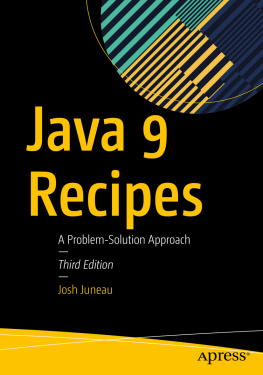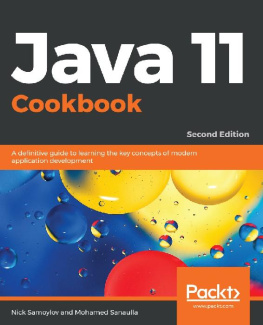Josh Juneau [Josh Juneau] - Java EE 8 Recipes: A Problem-Solution Approach
Here you can read online Josh Juneau [Josh Juneau] - Java EE 8 Recipes: A Problem-Solution Approach full text of the book (entire story) in english for free. Download pdf and epub, get meaning, cover and reviews about this ebook. year: 2018, publisher: Apress, genre: Computer. Description of the work, (preface) as well as reviews are available. Best literature library LitArk.com created for fans of good reading and offers a wide selection of genres:
Romance novel
Science fiction
Adventure
Detective
Science
History
Home and family
Prose
Art
Politics
Computer
Non-fiction
Religion
Business
Children
Humor
Choose a favorite category and find really read worthwhile books. Enjoy immersion in the world of imagination, feel the emotions of the characters or learn something new for yourself, make an fascinating discovery.
- Book:Java EE 8 Recipes: A Problem-Solution Approach
- Author:
- Publisher:Apress
- Genre:
- Year:2018
- Rating:3 / 5
- Favourites:Add to favourites
- Your mark:
Java EE 8 Recipes: A Problem-Solution Approach: summary, description and annotation
We offer to read an annotation, description, summary or preface (depends on what the author of the book "Java EE 8 Recipes: A Problem-Solution Approach" wrote himself). If you haven't found the necessary information about the book — write in the comments, we will try to find it.
Quickly find solutions to dozens of common programming problems with the Java Enterprise Edition Platform for small business web applications, enterprise database applications, and microservices solutions. Content is presented in the popular problem-solution format. Look up the programming problem that you want to solve. Read the solution. Apply the solution directly in your own code. Problem solved!
Java EE 8 Recipes provides you with effective and proven solutions that can be used to accomplish just about any task that you may encounter. You can feel confident using the reliable solutions that are demonstrated in this book in your personal or corporate environment.
Java is a mature programming language that has been refined over the years into a productive and lucrative language for those with the skills to wield it. One result of this years-long refining process is that that the language carries forward many older feature sets that no longer represent the best way of getting work accomplished. You can rest assured that Java EE 8 Recipes provides solutions using the most current approaches implemented in the most current Java Enterprise technologies, including JSON-P 1.1, JSF 2.3, and JAX-RS 2.1.
Build a streamlined and reliable application that uses the latest in Java technologies, and develop it much faster than you did with the older technologies. Rejuvenate your Java expertise to use the freshest capabilities, or perhaps learn Java Enterprise development for the first time and discover one of the most widely used and most powerful technologies available for application development today. Develop productively. Develop with proven technology. Develop with Java Enterprise Edition. The book:
- Teaches how to develop RESTful enterprise applications quickly using the most current Java EE technologies
- Explores different solutions for developing sophisticated web user interfaces
- Walks you through a myriad of different concepts to apply while working with databases using Java technologies
- Develop Java Enterprise applications using the latest in Java EE technologies
- Build great-looking user interfaces using Java Server Faces
- Employ Java Servlet technology and standard frameworks in developing professional web applications
- Create enterprise-level database applications using Enterprise Java Beans and JAX-RS RESTFul web services
- Make use of Arquillian to build a cohesive test suite for Java EE applications
- Manage Java EE application security through Java EEs container feature set
Java developers who want to develop effective and proven solutions without reading a lengthy manual and scrubbing for techniques. A beginning Java programmer will find the book handy for learning a variety of different solutions for the platform, while advanced developers will enjoy the ease of the problem-solution approach to quickly broaden their knowledge of the platforms latest technologies.
Josh Juneau [Josh Juneau]: author's other books
Who wrote Java EE 8 Recipes: A Problem-Solution Approach? Find out the surname, the name of the author of the book and a list of all author's works by series.

![Josh Juneau [Josh Juneau] Java EE 8 Recipes: A Problem-Solution Approach](/uploads/posts/book/119371/thumbs/josh-juneau-josh-juneau-java-ee-8-recipes-a.jpg)







![Josh Juneau [Josh Juneau] - Java 9 Recipes: A Problem-Solution Approach, Third Edition](/uploads/posts/book/119388/thumbs/josh-juneau-josh-juneau-java-9-recipes-a.jpg)

![Yakov Fain [Yakov Fain] - Java Programming 24-Hour Trainer, 2nd Edition](/uploads/posts/book/119348/thumbs/yakov-fain-yakov-fain-java-programming-24-hour.jpg)

